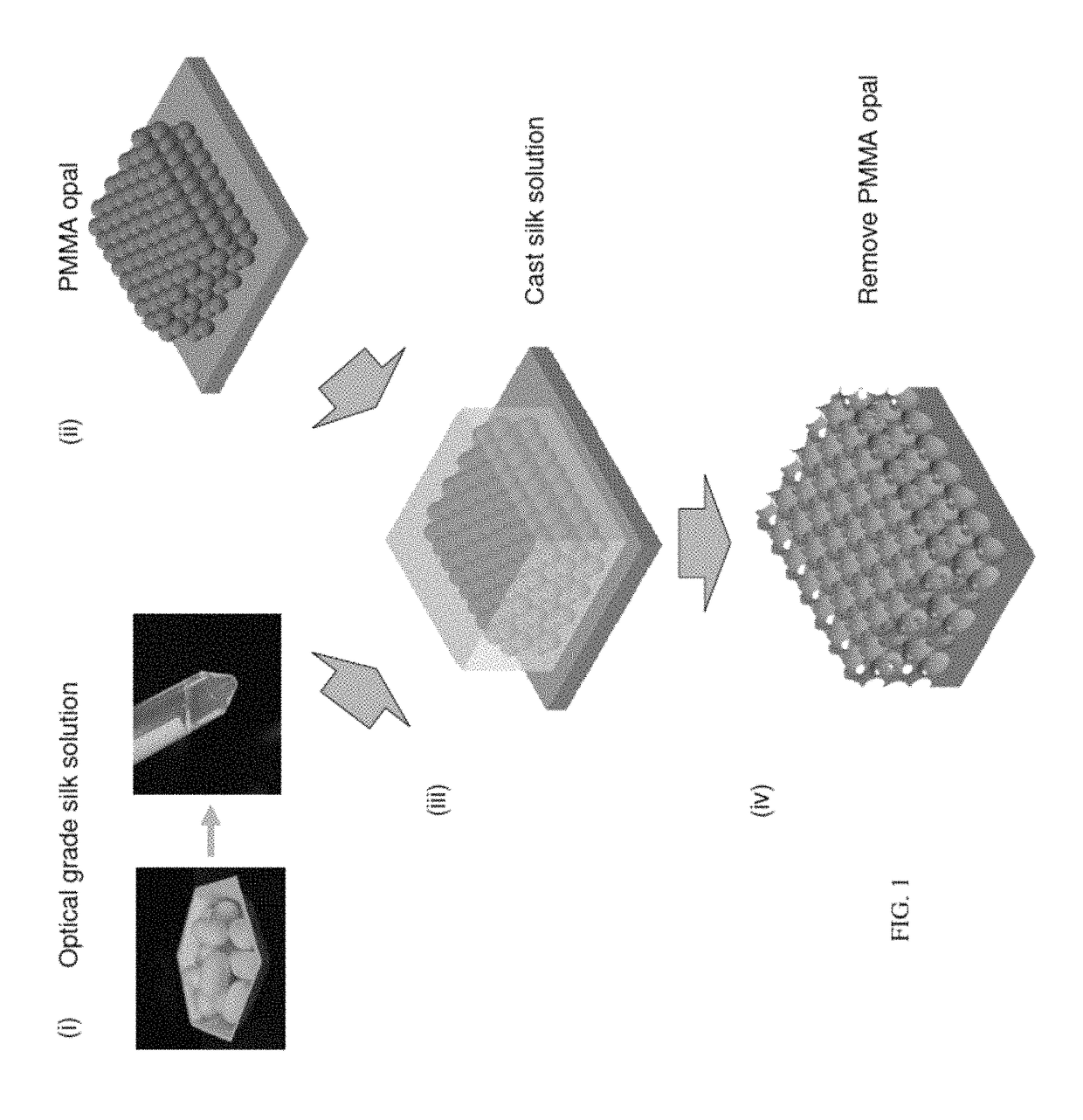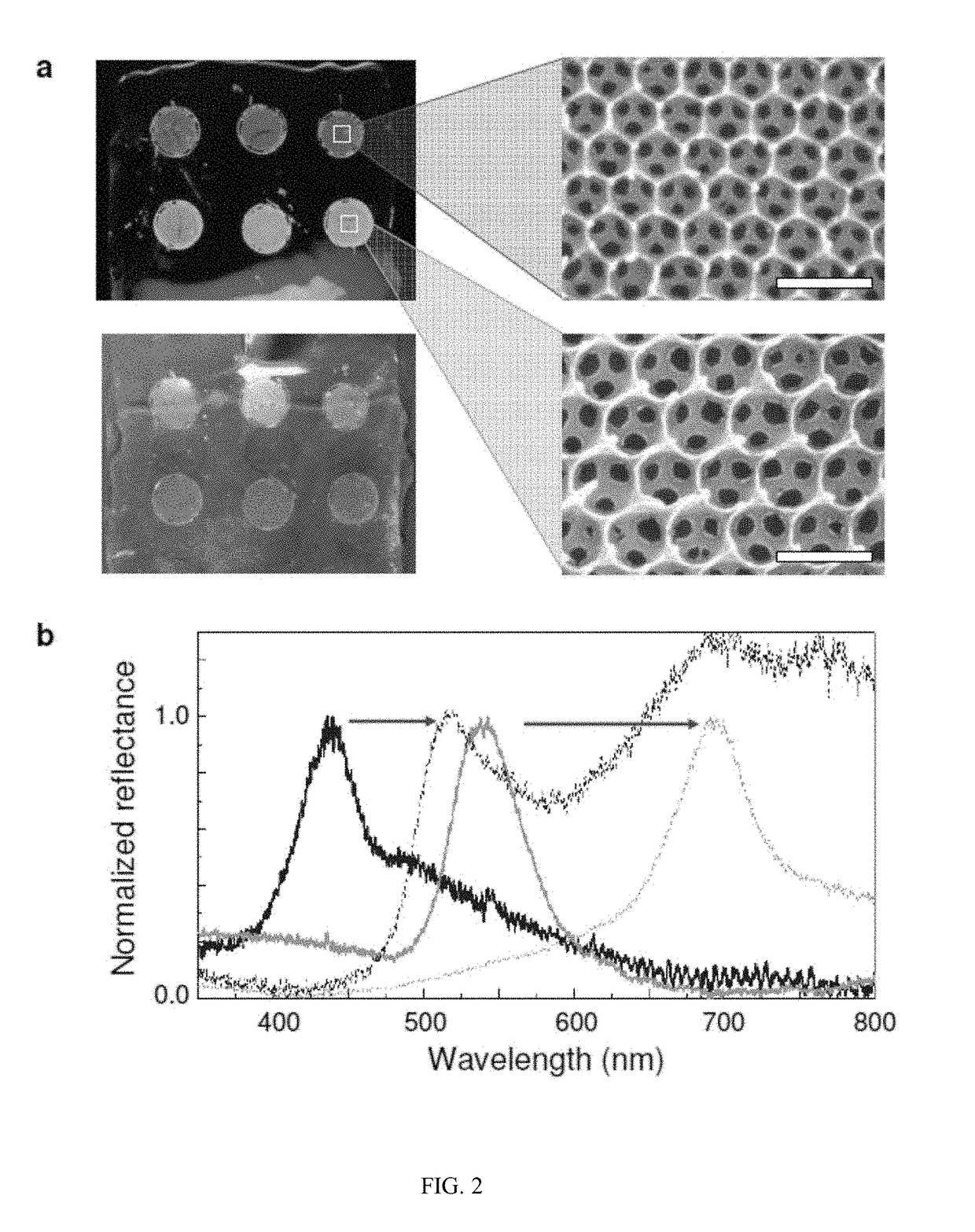Signal enhancement by silk photonic crystals
a technology of photonic crystals and silk, applied in the field of silk-based engineering of structural colors, can solve the problems of selective reflection of particular light wavelengths through constructive and destructive interference, and light encountering these minute structures is subject to optical phenomena, and achieve the effect of enhancing the absorption of energy by gold nanoparticles and enhancing the effect of photosensitive compounds
- Summary
- Abstract
- Description
- Claims
- Application Information
AI Technical Summary
Benefits of technology
Problems solved by technology
Method used
Image
Examples
example 1
SIO Coupled to Thermogenic Plasmonic Nanoparticles
[0136]Since the beginning of human civilization, natural materials have served as an extraordinary source for medical application such as using nacre for dental implants in Mayan cultures and spider webs as wound dressing in Greeks and Romans times1, 2. Silk, a highly desired and used textile spread around the World through the Silk-road from ancient China over the past five millennia, can be retooled to provide new opportunities in biomedical application at the overlap of technology and biology owing to its excellent mechanical and optical properties along with biocompatibility, and biodegradability3, 4. In some embodiments, silk fibroin obtained from the Bombyx mori caterpillar can have outstanding properties as a transparent optical material5. These properties can facilitate the creation of a variety of optical components such as microlens arrays6, waveguides7, and diffraction gratings8 by simple patterning of silk films. In some ...
example 2
Silk-Based Hybrid Photonic-Plasmonic Crystal with Improved Sensing Capability
[0188]Referring to FIGS. 14 to 17, a silk-based hybrid photonic-plasmonic crystal (HPPC) structure for use as a refractive index (RI) sensor was prepared. The hybrid structure is composed of a silk inverse opal (SIO) and a thin silver (Ag) film deposited on the structured surface of the inverse opal surface and was fabricated using a template method as described in S. Kim, A. N. Mitropoulos, J. D. Spitzberg, H. Tao, D. L. Kaplan, F. G. Omenetto, Nature Photon. (in press). The silk-HPPC is a hybrid photonic device composed of an inverse opal and a plasmonic crystal realized with a pure protein material substrate. In the transmission spectra, the silk-HPPC simultaneously exhibits both a pseudo-PBG and an extraordinary transmission (EOT). The SIO improves the response by the EOT as well as exhibiting a spectral response through the pseudo-PBG shift. Finite difference time domain (FDTD) simulations were perform...
example 3
Fluorescent Enhancement with a Quantum Dot-Doped Silk Photonic Crystal
[0202]Experiments in this Example demonstrate the utility of silk photonic crystals for photonic applications by exploring the use of doped (quantum dots and fluorescence) crystals.
[0203]In this Example, the quantum-dots (QDs) were dispersed in an aqueous solution and were mixed into the silk fibroin solution at a concentration of 0.125 μM. The SiO2 layer has a refractive index of 1.45, which being lower than silk (nsilk=1.54) guides photons into a silk-slab. Silk photonic crystals with lattice constants (Λ) ranging from 400-700 nm with 50 nm increments were generated. The sample was excited from top surface using a 480 nm LED and the fluorescent emission was collected by an objective lens as shown in FIG. 19a. The excitation light was blocked using a 610 nm long pass filter. The multispectral CCD image and spectra of the patterns are shown in FIGS. 19b-c. A 5-fold increase in intensity as shown in FIG. 19b was ob...
PUM
 Login to View More
Login to View More Abstract
Description
Claims
Application Information
 Login to View More
Login to View More - R&D
- Intellectual Property
- Life Sciences
- Materials
- Tech Scout
- Unparalleled Data Quality
- Higher Quality Content
- 60% Fewer Hallucinations
Browse by: Latest US Patents, China's latest patents, Technical Efficacy Thesaurus, Application Domain, Technology Topic, Popular Technical Reports.
© 2025 PatSnap. All rights reserved.Legal|Privacy policy|Modern Slavery Act Transparency Statement|Sitemap|About US| Contact US: help@patsnap.com



